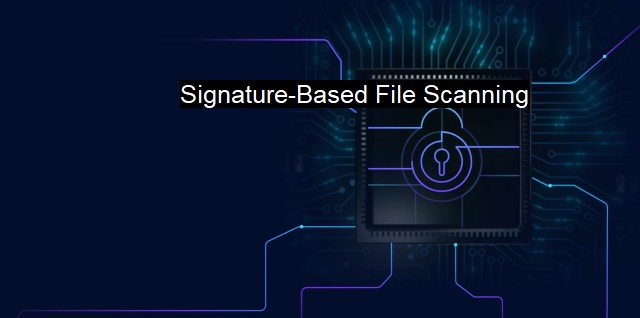What is Signature-Based File Scanning?
The Importance of Signature-Based File Scanning in Cybersecurity: Detecting Known Malware with Accuracy
Signature-Based File Scanning is a primary technique used in anti-virus and cybersecurity software to identify, detect, and counter issues like Trojans, viruses, and worms. This process is established on a mixed database of virus definitions or 'signatures'. Whenever a file or program has a payload subservient to these signatures or acts in any way resembling this predefined shady behavior, it is identified as a threat and quarantined.Functionality-wise, Signature-Based File Scanning is very direct and lends itself well to managing known malware threats. every incoming file is compared piece by piece to a list of infamous code segments. On congruence, the system records a hit, which allows it to locate the suspect code snippet and decommission it. Hence, malware which functions identically to its previous cases can be easily spotted and neutralized. This comparison procedure enables the system to work with high efficiency when dealing with a malware strain it has encountered before.
Each digital virus has its own unique binary pattern. By recognizing and responding to these patterns, the antivirus software acts as an immune system for the computer its protecting. These patterns — these distinct characteristics that identify a particular virus — are what cybersecurity professionals refer to as "signatures". To compile a dictionary of all known virus signatures, cyber professionals painstakingly dissect caught malware programs and isolate their distinguishing elements: a define-able method of intrusion, discernable methods of sowing discord undetected, significant recurring structure, or strategically changing names and file locations to gummy the effort of detection efforts.
The immediate advantage herein is that Signature-Based File Scanning lends itself well to up-to-the-minute responsiveness to live threats as they are detected in the wild. Software engineers can update signature libraries which are then passed along to users in regular installments. Staying up-to-date with these packages can go a long way in fortifying users against more recent threats, while the added benefit of real-time scanning can catch malware before it infiltrates a system.
There are downsides to solely relying upon this method. The determination of the system remains relative to the size, comprehensiveness, and present nature of its signature database. it can only deflect threats for what it knows to potentially be unsafe. To rebuff malware it doesn't recognize, the system is often found wanting. Many modern-day cyber threats such as zero-day attacks can bypass signature-based defenses simply because they haven't been enlisted in the database.
As the digital landscape transforms, hackers change their techniques, creating new malware. Therefore, signature databases require constant updating to keep pace with emerging threats - a task that is constant, posing significant challenges to cybersecurity service providers.
The utility of Signature-Based File Scanning is significantly curtailed given the volume and complexity of modern data exchanges. For businesses that deal with copious data every day — all of which has to be rigorously guarded — Signature-Based Scanning techniques might not provide a comprehensive solution.
Despite their limitations, Signature-Based File Scanners do offer a line of defense in a broader cybersecurity strategy. In combination with advanced backstops like heuristic and behavior-based scanners, these solutions help to sufficiently arm systems against a wide variety of threats.
Understanding the advantages and caveats associated with signature-based file scanning is crucial in cyberdefense. While it fights off known cyber threats confidently, its effectiveness against more unfamiliar or newly sprung threats becomes less certain. As no system can claim absoluteness, continually advancing towards innovatively balanced cybersecurity solutions, like supplementing signature scanners with more comprehensive methods, brings one a step forward to more robust antivirus protection.

Signature-Based File Scanning FAQs
What is signature-based file scanning?
Signature-based file scanning is a method used by antivirus software to detect malware by matching a file's signature (unique code pattern) to a database of known malware signatures.How does signature-based file scanning work?
Signature-based file scanning works by comparing the unique code patterns in a file to a database of known malware signatures. If a match is found, the antivirus software can take action to remove or quarantine the file.What are the limitations of signature-based file scanning?
The main limitation of signature-based file scanning is that it can only detect known malware signatures. New or unknown malware may not be detected by this method. Additionally, malware can be designed to evade signature-based detection by using techniques such as file obfuscation or encryption.Is signature-based file scanning still effective?
While signature-based file scanning is not foolproof, it is still an effective method for detecting and preventing known malware. However, it should be used in conjunction with other security measures, such as behavior-based detection and regular software updates, to provide comprehensive protection against cyber threats.| | A | | | B | | | C | | | D | | | E | | | F | | | G | | | H | | | I | | | J | | | K | | | L | | | M | |
| | N | | | O | | | P | | | Q | | | R | | | S | | | T | | | U | | | V | | | W | | | X | | | Y | | | Z | |
| | 1 | | | 2 | | | 3 | | | 4 | | | 7 | | | 8 | | |||||||